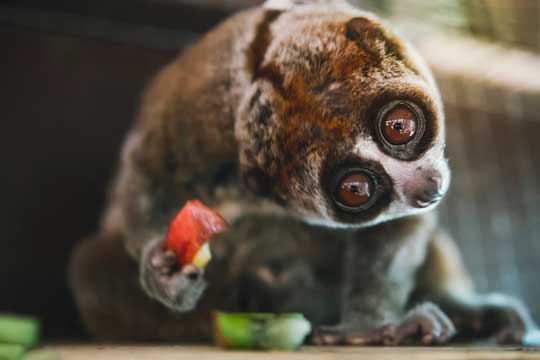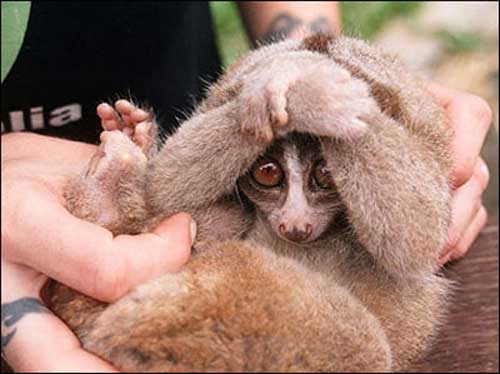|
In my previous Awesome Animal feature I talked about the solenodon, an unusual venomous mammal. Venom is extremely rare in mammals, so I thought it would be fun to look at another example, the slow loris. Okay, that's not quite true. The real reason I wanted to feature the slow loris is that I just love the way this critter looks. Huge, round, saucer eyes. Funny hands and feet. Round faces... they are Earth's version of the Ewok, only much cuter. What the heck is a Slow Loris? Slow lorises are an unusual, primitive group of primates (primates is the order of mammals that includes humans, chimps, gorillas, orangutans, gibbons, new and old world monkeys, tarsiers, lemurs, and lorises). The eight species of slow loris live throughout Southeast Asia. They are nocturnal, tree-dwelling mammals that eat just about anything, including small animals, eggs, fruits, tree sap, flower nectar, and leafy vegetation. They are generally slow-moving, but they can be fast if they want to... apparently they rarely want to. They make their way through the tropical forest canopy at a snail's pace, and like sloths, they will often become motionless for hours at a time, hanging upside down from a branch with hands and feet that seem to never get tired of holding on. Amazing Facts about the Slow Loris First we need to talk about why we consider these animals to be venomous. If you read my previous email about solenodons, you may remember that only a few mammals are considered venomous. There are solenodons, of course, as well as two species of shrew. Vampire bats could be considered venomous because their saliva has compounds that prevent blood from clotting. And the male platypus can inject venom with spurs on its feet. The slow loris has a bizarre way of getting venom onto its teeth. Instead of having venom glands in their mouth, slow lorises get their venom from their armpits. When a slow loris decides it needs to be aggressive, it quickly raises its arms high, locks its hands together above its head, sticks its face into its armpit, and licks the oil-secreting venom glands located there. The venomous oil collects in the narrow grooves in the loris's teeth, which are sharp enough to slice right into bone. Then, when the creature bites, the venom is injected. Slow loris venom isn't completely understood yet, but we do know one component is similar to the protein that is found in cat dander that triggers severe allergic reactions in many humans. But that's only one of many substances in the venom. Others are known to cause other problems, including intense pain. Oddly, the purpose of this venom has been poorly understood until recently. It is not for subduing its prey—lorises eat mostly tree sap, vegetation, and small animals that would not need to be subdued. For some time, the leading hypothesis was that it was for defense against predators. As it turns out, this is not the case either. For years, there has been anecdotal evidence that slow lorises were dangerous to each other. Zoo and animal rescue workers report that the most frequent cause of death among slow lorises is from biting each other. Illegal pet traders report that they routinely remove the teeth from captive lorises they intend to sell. Why? Not to protect the human handlers, but to protect the lorises from each other. Loris venom causes necrosis (death of the tissue near the bite), and bitten lorises would die or lose large portions of their skin, making them difficult to sell (yes, I agree... this illegal pet trade is terrible). Recently, a dedicated team of researchers put radio collars on 82 Javan slow lorises and spent eight years tracking and studying them! Only one of these lorises was lost to a predator (a feral dog), but many of them suffered from severe bite wounds from other lorises. So, what is the conclusion? Slow lorises are extremely territorial, and they use their nasty venom primarily in territorial disputes, or disputes over potential mates. Slow lorises, in other words, are constantly in conflict with each other! They are remarkably cute, but looks can be deceiving. There are some viral videos of people "tickling" a slow loris. The creature raises its arms above its head, and the video claims the loris really likes to be tickled. Umm... no. When a slow loris raises its arms, it is frightened and being defensive! Check out this video about the slow loris. Oddly, slow lorises are usually reluctant to bite humans. For hundreds of years, slow lorises have had interesting and often problematic connections with humans. One of the better stories is from Borneo. The indigenous people in Borneo believed slow lorises were gatekeepers to the heavens, and that every person had their own slow loris assigned to them, which would be waiting to great them in the afterlife. Malay people believed slow lorises were plagued by ghosts, and that was why they often covered their face and eyes with their hands. Unfortunately, many of the other human connections are more harmful to slow lorises. They have traditionally been hunted based on various beliefs that their body parts could be used for all manner of health benefits. The body parts were thought to bring a curse to enemies if buried under a house or a road where the enemy frequents. The list goes on and on... In Java, women believed if they put a slow loris skull in a jug of water, the water would make their husband more agreeable and docile (because slow lorises themselves are agreeable and docile). In Cambodia, it was thought that slow lorises had medicinal powers because they could never be killed with only one hit with a stick. Slow loris meat has long been eaten as an aphrodisiac (but only for men, not women). In their natives ranges, slow lorises are often kept for pets (usually illegally). In Indonesia, they are thought of as a living toy for young children. As you can imagine, many of these lorises die from mistreatment. Pet sellers often remove their teeth, frequently resulting in death from bleeding. Fortunately, slow lorises are now protected from international trade, and all countries in which they live have laws to protect them from local trade (although illegal collecting still occurs). So, the Slow Loris deserves a place in the M.A.H.O.F. (Marvelous Animal Hall of Fame). FUN FACT: The word marvelous originated in about 1300. It came from the Middle French merveilleus, originally meaning "causing wonder, of wonderful appearance or quality." Marvel comes from the Latin mīrābilis, meaning “to marvel or wonder at.” Adding the suffix -ous turns it into an adjective (the suffix means “possessing”). Marvelous can also mean "improbable or incredible," as in "the marvelous events of Greek myth." So, marvelous is another way to say awesome! Photo Credits:
- Slow loris with piece of apple in hand - DepositPhotos - Slow loris hanging upside down - DepositPhotos - Woman holding slow loris - DepositPhotos - Slow loris (last photo) with rust-colored fur - DepositPhotos
0 Comments
Leave a Reply. |
Stan's Cogitations
Everyone needs a creative outlet. That's why I write. Archives
July 2024
|






 RSS Feed
RSS Feed